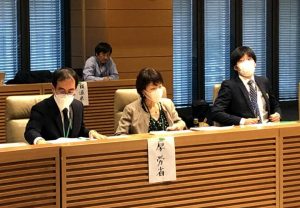Chosei coal mine disaster 82 years on — Remains of victims left buried at sea, Part 3: Japanese government
Feb. 3, 2024
Japanese government maintains its stance that exhumation of victims’ is difficult
South Korean government to discuss how to move ahead with effort
by Minami Yamashita, Staff Writer
On December 8, during a meeting with families of the Korean victims of the Chosei coal mine flooding disaster and a civic group from Ube City in Yamaguchi Prefecture that works to preserve the history of the accident, Masako Nakamura, chief of the humanitarian research office of Japan’s Ministry of Health, Labour and Welfare, reiterated the government stance that, “It would be difficult to conduct a survey.”
The Chosei coal mine disaster occurred in a mine under the seabed off the coast of Ube City in 1942 during World War II. The Japanese government has continued to insist that it would be difficult to exhume the victims’ remains because they are under the sea and it is unclear where and how deep they are buried.
Bereaved families and Japanese government remain far apart
For the meeting, around 130 people, including the civic group’s supporters and members of the Japanese and South Korean media, gathered at the office building of the Japan’s House of Representatives, in Tokyo. The families of victims called for the government “to uphold the bare minimum of human morality by exhuming the remains of the victims and returning them to their homes.” But the group and MHLW officials appeared to be far apart on the issue. The families requested that the ministry at least explore the possibility of recovering the remains. ”If, at your own discretion, you’ve already decided to not conduct the survey, you could change your stance.” Members of the civic group and lawmakers who support the bereaved families spoke up and proposed a survey carried out with underwater drones. To that, Ms. Nakamura replied, “The range of an underwater drone is about 200 meters. It would be difficult to implement such a survey because there are no realistic prospects for success.”
The national government has continued to engage in recovering the remains of war dead from the sites of fierce battles on islands in the Pacific Ocean and from where Japanese prisoners of war were detained in Siberia in the former Soviet Union. A law designed to facilitate the recovery of such remains enacted in 2016 stipulates that such work is the “responsibility of the national government.” But the victims of the Chosei coal mine disaster fall outside that legal framework.
As a response to a Japan-Republic of Korea Summit Meeting held in 2004, the Japanese government now appropriates a budget of about 10 million yen each year for a project to return the remains of civilian recruits who had been mobilized from the Korean Peninsula during Japan’s colonial rule and died in Japan. In the government’s view, the budget does not cover surveys for the excavation of victims, because that money is earmarked for visits made to temples or cemeteries to confirm the status and location of stored victims’ remains for which the return to families is considered possible.
“Show good faith”
Son Bongsu, 66, secretary-general of an association of bereaved family members of the Korean victims, was indignant. “Are standards for the collection and return of remains really necessary?” Yoko Inoue, 73, co-chair of the Japanese civic group for memorializing the disaster, said, “If it is deemed, even without conducting a survey, that exhumation of the remains was too difficult, what would happen to the dignity of the lives of the victims? We want the government to show good faith with respect to this issue.”
Toward the end of the nearly two-hour meeting, a faint ray of hope appeared. When a member of the civic group expressed the desire to have engineers participate in future meetings involving the survey, Ms. Nakamura responded, “I have no intention of limiting such activities. I hope we can continue to discuss this issue into the future.” An official from Japan’s Ministry of Foreign Affairs who was also present at the meeting commented, “We have shared with the South Korean government our recognition of the importance of promptly returning the remains of Koreans still in Japan. We aim to collaborate with the relevant ministries and agencies to achieve that goal.”
In September of last year, the South Korean government responded to an inquiry from the association of bereaved families of Korean victims regarding the excavation of the remains of victims of the Chosei coal mine disaster, remarking that it would continue to hold discussions with the Japanese government to ensure the project moves ahead. Ms. Inoue explained her group’s objective. “The activities of citizens’ groups have limits. We hope to form a project team that includes the national government, specialists, and the South Korean government.” Public support for the project is hoped for as the bereaved family members of victims grow elderly.
(Originally published on February 3, 2024)








